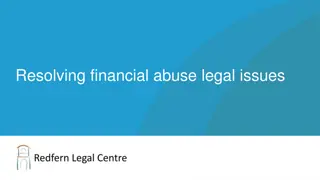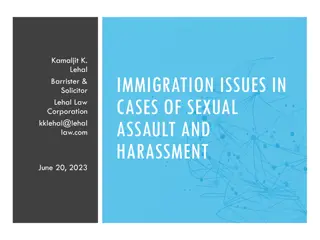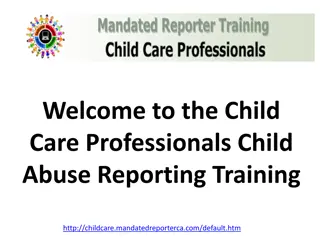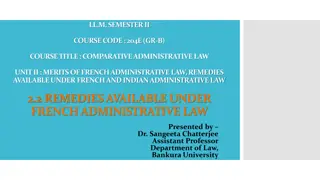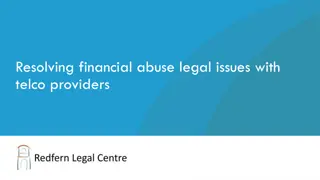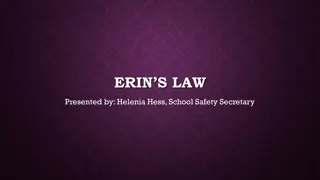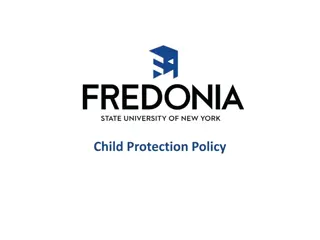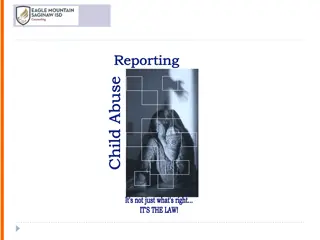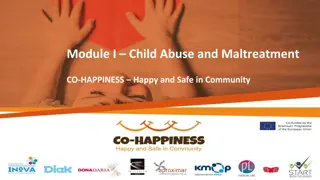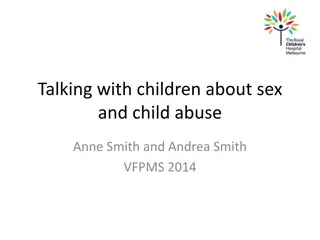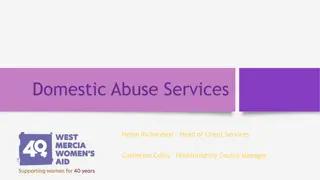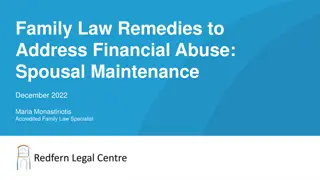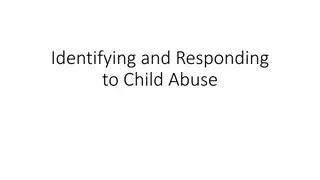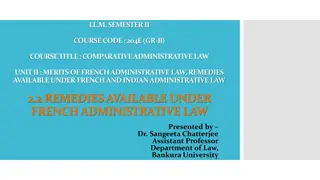Understanding Financial Abuse in Family Law: Child Support and Legal Remedies
Financial abuse is a form of domestic violence where abusers use money to gain power and control over their partners, impacting child support and family law matters. This article explores common behaviors, legal responses, and resources related to financial abuse in the context of child support and family law.
Download Presentation

Please find below an Image/Link to download the presentation.
The content on the website is provided AS IS for your information and personal use only. It may not be sold, licensed, or shared on other websites without obtaining consent from the author. Download presentation by click this link. If you encounter any issues during the download, it is possible that the publisher has removed the file from their server.
E N D
Presentation Transcript
Family Law and Financial Abuse Child Support March 2023 Maria Monastiriotis Accredited Family Law Specialist
Acknowledgement Of Country
Outline 1. 2. 3. 4. 5. 6. 7. 8. 9. 10. Child Support Agreements 11. Questions Understanding financial abuse Pathways Family Law Act Understanding Child Support Child Support Assessment Terminating Child Support Event Change of Assessment Child Maintenance Orders - Family Law Act Child Maintenance Orders - Child Support Assessment Act RESOURCES: www.rlc.org.au/training/resources/financial-abuse
Understanding financial abuse
What is financial abuse? Financial or economic abuse is a form of domestic violence where an abuser uses money to gain power and to control their partner. Domestic violence is a pattern of abusive behaviour in an intimate relationship or other type of family relationship where one person assumes a position of power over another and causes fear It is often referred to as a pattern of coercion and control. (1800RESPECT) There is no single agreed legal definition of domestic violence in Australia.
Common behaviours Control over day-to-day household finances & material wellbeing Denying accumulation of personal assets or eroding those assets Manipulating credit and debt to the abused partner s disadvantage Blocking access to social and economic participation Financially monitoring, over-controlling and scrutinising their partner Refusing to contribute Exploiting women sexually in exchange for money SOURCE: Restoring Financial Safety: Legal Responses to Economic Abuse (see Resources)
Financial abuse behaviours relating to children and child support Denying access to money to pay for the financial needs of the children Denying access to a motor vehicle Partner placing school fees in person s name Partner threatening custody because they are the stronger financial party Partner changing employment or using business to reduce income to avoid child support liability
Financial abuse behaviours #2 Partner selling or threatening to sell children s belongings, including toys, furniture, computer, iPad and other devices needed for school (the reverse is buying the affection of the children). Partner refusing access to health insurance Partner cutting access to Foxtel, Netflix, internet Partner cutting off any services that benefit the children in an attempt to control person
Financial abuse behaviours #3 Partner placing pressure on person to contribute to mortgage even though person has left the home with the children Partner interrogating children about money or blaming person for their financial position Destroying or damaging children s property Partner failing to lodge taxation returns so lower income is used for child support assessment
How prevalent is it in Australia? 7.1% of people who identify as male 15.7% of people who identify as female 11.5% of Australians SOURCE: Kutin, Russell and Reid, Economic abuse between intimate partners in Australia: prevalence, health status, disability and financial stress Australian and New Zealand Journal of Public Health 2017
Financial abuse continues after separation, creating financial and legal difficulties which impact the person and their children.
Informed Decisions Several pathways may be available to address financial abuse and consideration needs to be given to the merits of each so that informed decisions can be made. The pathways may include: Reporting fraudulent behaviour to the police Making a complaint to the Australian Financial Complaints Authority who have capacity to award compensation and damages for stress where a financial institution has acted inappropriately. Seeking waiver of a liability Making an Application for financial hardship Seeking damages from the District or Supreme Court. Filing an Application seeking urgent, interim or final orders from the Federal Circuit and Family Court of Australia. 13
Common financial abuse issues Partner refusing to contribute to joint debts (eg. rent, mortgage repayments, car loans, school fees) or pay child support Partner withdrawing money from a joint bank account or cutting off access to joint accounts Partner transferring joint property into another person s name to avoid a Family Law claim Being coerced to sign documents, take out loans, sign personal guarantees or make false declarations Identity theft (eg. accounts fraudulently opened by a partner or ex-partner using personal information) Partner taking control of finances and assets eg. car, social security benefits, superannuation.
Credit, debt & consumer law pathways Application for financial hardship assistance (eg. debt waivers, payment plans) Consumer complaint on the basis of: o o Breaches of the Consumer Credit Law Breaches of relevant industry guidelines and codes of practice External dispute resolution schemes (eg. Australian Financial Complaints Authority, Telecommunications Industry Ombudsman, Energy and Water Ombudsman NSW) Request for fines to be withdrawn or written-off / waived Debt recovery proceedings (typically through the Local Court)
Potential outcomes Reducing the amount to pay Full or partial waiver Waiver of interest and/or fees Severing liability Cancellation of account Waiver of cancellation fees Extending the time to pay Moratorium (short or long-term hold on repayments) Hold on fees / interest / charges Payment plan Credit reporting No default listing Removal of adverse credit information eg. defaults, enquiries, repayment history information Compensation Compensation for financial and non- financial loss Refund of amounts paid
Who can help Free financial counselling eg. National Debt Helpline 1800 007 007 Local community legal centre - free advice about credit & debt, DV, AVOs, victims compensation RLC s Financial Abuse Service NSW - advice about financial abuse within NSW Specialist legal centres - free advice about consumer credit issues: o NSW: Financial Rights Legal Centre o ACT: Care Consumer Law o VIC: Consumer Action Law Centre o WA: Consumer Credit Legal Service WA o QLD: Caxton Legal Centre o SA: Consumer Credit Law Centre SA o TAS & NT: There are no statewide consumer credit legal services contact local CLC Links to these agencies are here: www.rlc.org.au/training/resources/financial-abuse
Definition of Family Violence Family violence is defined under the Family Law Act 1975 (as amended) under section 4AB. It is defined as violent, threatening or other behaviour by a person that coerces a member of the person s family or causes the family member to be fearful. The definition lists several examples of family violence. The list is inclusive, not exclusive.
Section 4AB The behaviour includes: unreasonably denying the family member the financial autonomy that he or she would otherwise have had; or unreasonably withholding financial support needed to meet the reasonable living expenses of the family member, or his or her child, at a time when the family member is entirely or predominantly dependent on the person for financial support. Financial abuse, also known as economic abuse, was only added to the definition of family violence in the Family Law Act 1975, in 2012.
The Family Law Act makes no specific provisions for dealing with financial abuse as a matter to be considered when determining a property settlement.
Understanding Child Support
Avenues to obtain Child Support Departure Order from the Federal Circuit and Family Court of Australia Informal arrangement Child Support Assessment Limited Child Support Agreement Binding Child Support Agreement Adult child maintenance
Child Support Assessment
Child Support Assessment Both parents must be Australian residents, or one parent is a resident, and the other parent is resident of a reciprocating jurisdiction. Must be legal parent or non-parent carer Child support period starts when a person makes an application for child support and can last for up to 15 months or when notice is received from the ATO of income for the most recent financial year. Based on childrens care arrangements Assessment ends when child attains 18 years or completes secondary education whichever occurs last or if care arrangements change, if child marries or is in a de facto relationship, child no longer a resident of Australia or child dies.
Changes relating to the child Assessment will end if any of the following occur: the child turns 18, or the child completes secondary education the child marries or starts living in a de facto relationship someone else adopts the child the child dies.
Jurisdiction Assessment will also end if all of the following occur: the child is no longer in Australia the child is no longer an Australian resident or citizen the person entitled to get child support is not a resident of a reciprocating jurisdiction.
Changes relating to care Assessment will end if all of the following occur: care change more than 26 weeks after it occurs a parent or non-parent carer stops having 35% care or more the other parent starts having 35% care or more. Assessment will also end if both of the following occur: both parents have less than 35% care of the child there s no non-parent carer entitled to receive child support.
Changes relating to parents Assessment will end if any of the following occur: Parties enter, or have entered, into a binding child support agreement that ends the assessment one of the parents in the assessment dies and there is no non-parent carer entitled to receive child support the parents have been reconciled for 6 months or more both parents stop being residents of Australia.
Other reasons Other reasons assessment will end are if any of the following occur: someone else starts caring for the child under a child welfare law in South Australia or Western Australia Notice that the receiving parent is now a New Zealand resident the paying parent stops being a resident of Australia or of a reciprocating jurisdiction another ongoing child support liability, such as an overseas child support liability, is registered for the same parents and child.
Change of assessment
Child Support remedies: 10 grounds for a change of assessment 1. The costs of raising the child are significantly affected by the high costs of spending time or communicating with the child. 2. The costs of raising the child are significantly affected because of their special needs. 3. The costs of raising the child are significantly affected because the child is being cared for, educated or trained in the way both parents intended. 4. The child support assessment is unfair because of the child's income, earning capacity, property or financial resources. 5. The child support assessment is unfair because person has transferred money, goods or property to child, the receiving parent or a third party, for the child's benefit.
Child Support remedies: 10 grounds for a change of assessment (cont.) 6. The costs of raising the child are significantly affected by the parent or nonparent carer s childcare costs, and the child is under 12 years of age. 7. Person s necessary expenses significantly reduce capacity to support the child. 8. The child support assessment is unfair because of the income, earning capacity, property or financial resources of one or both parents. 9. Person s capacity to support the child is significantly reduced because they are supporting another child or person. 10. Person s responsibility to support a resident child significantly reduces their capacity to support another child.
Review of Child Support Decisions Objecting to the decision of the Child Support Registrar Court Application to the Administrative Appeals Tribunal Applications, appeals and Orders
Child Maintenance Orders Family Law Act
Objects that children have their proper needs met from reasonable and adequate shares in the income, earning capacity, property and financial resources of both of their parents; and that parents share equitably in the support of their children.
Who can apply? Parent Child Grandparent Any person with care, welfare or development of the child Child under guardianship or child welfare order- must have daily care
Obligations of step-parents The step-parent of a child has the duty of maintaining a child if, and only if, a court, by order under section 66M, determines that it is proper for the step-parent to have that duty. 39
Section 66M the matters referred to in sections 60F, 66B and 66C; and the length and circumstances of the marriage to, or relationship with, the relevant parent of the child; and the relationship that has existed between the step-parent and the child; and the arrangements that have existed for the maintenance of the child; and any special circumstances which, if not taken into account in the particular case, would result in injustice or undue hardship to any person.
Adult Child Maintenance Section 66L A parent can seek adult child maintenance for a child that is over the age of 18, and who has financial needs due to their ongoing tertiary education or some mental or physical disability. The court considers the following factors when assessing an application for a child maintenance order: 1. The age of the child; 2. Any special needs of the child; 3. The income, financial earning capacity, property and financial resources of the child; and 4. How the child is being, and in which the parents expected the child to be, educated or trained. NB: A child can also make the application on their own behalf.
Child Maintenance Orders Child Support Assessment Act
Child Support Registrar Court applications that can be made under the CSA Act In some circumstances, the CSA Act allows parents to apply directly to a court with family law jurisdiction for a range of orders. The parties to court proceedings under the CSA Act are the parents and any non- parent carer (where relevant). However, the Registrar must be served with a copy of any application or appeal (rule 1.13(4)(c) Federal Circuit and Family Court of Australia (Family Law) Rules 2021). The Registrar may intervene in any court proceedings under the CSA Act (section 145). If the Registrar intervenes in court proceedings, the Registrar is taken to be a party and has all the rights, duties and obligations of a party to the proceedings.
Orders that can be made by a court Leave to seek a change of assessment for period that is more than 18 months earlier Payment of child support to be paid in a form other than a periodic amount or as a lump sum Change Child Support assessment in special circumstances Paternity Declaration S106A and S107 S116 S111 and S112 S123 An order to recover an amount where no child support liability existed Other powers of the court- declare an application frivolous or vexatious Application to set aside child support agreement Urgent maintenance orders S136 S139 S143
Stay of Orders Must seek a stay if assessment in place
Child Support Departure Order Grounds for a departure order have been established Step 1 It is just and equitable to make the orders Step 2 Whether it is otherwise proper to make the orders Step 3
Grounds for a Child Support Departure Order The court will only be able to make a departure order where one of the following circumstances exists: Where the Agency is unable to make a decision regarding an application for a change of assessment; or Where the parties already have matters before the court. An example would be that there are currently parenting matters being decided by the court.
Urgent Child Maintenance The Federal Circuit and Family Court of Australia has the power to make an urgent order for child maintenance until the child support assessment commences
Enforcement Enforcement of lodgments of taxation returns and obtaining tax refunds Garnishing wages Travel bans
Child Support Agreements



